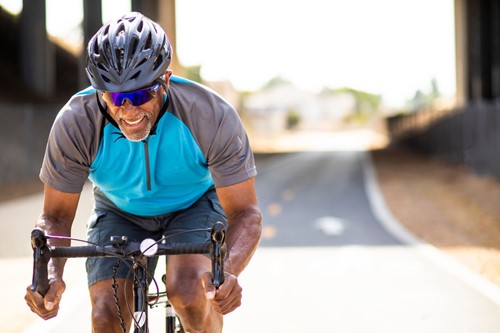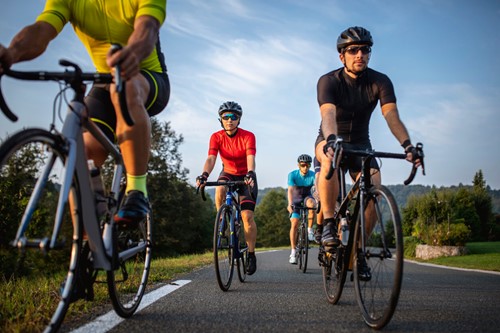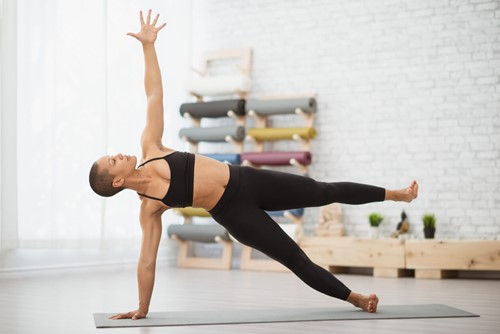Our Top 10 Tips For Training For A Sportive

If you’re an experienced cyclist, you’ll be familiar with sportive events – and the chances are you’ve completed one at some point.
But if you’re new to cycling, the prospect of a sportive is completely new, unfamiliar, and possibly daunting.
A sportive to a cyclist is what a marathon is to a budding long-distance runner – in many ways, a target. It involves completing a set route and can range from 50 to 150 miles in length. So, as well as being motivated and determined, you need to have a lot of background knowledge to complete a sportive. After all, knowledge is power.
With that in mind, here are our top ten tips for training for a sportive.
Table of contents
1. Build a good indoor setup
2. Nail your nutrition
3. Establish a solid routine
4. Build a good base fitness
5. Ensure your training is progressive
6. Get used to riding in groups
7. Turn commuting into training
8. Work on your strength and conditioning in the gym
9. Time your taper
10. Get comfortable with climbing
1. Build a good indoor setup
You can never fully rely on British weather – regardless of what time of year it is.
However, even if you live in the UK, bad weather shouldn’t be a hindrance when it comes to training for a sportive. In fact, you can use it to your advantage.
Establishing a good indoor training setup means you can train whenever you want. You’re not held back by rain, sleet, snow – or traffic!
Although there’s nothing better than the ‘real thing’, an indoor bike is still a more than capable alternative when the elements are against you.
Basic turbo trainer technology and software, such as Zwift, will often give you estimated power outputs. More advanced equipment like Wattbike gives highly accurate measures, allowing you to constantly keep track of your sportive training.
Related: Best exercise bikes – smart indoor bikes for home workouts
2. Nail your nutrition

Though this tip might seem self-explanatory, getting your diet and nutrition right in the lead-up to your sportive can make all the difference.
As a cyclist, it’s essential to learn what your body likes while riding. For example, can you get by merely on energy drinks and gels, or do you require something more substantial like a sandwich or a piece of fruit?
What you consume during your training should, as much as possible, mirror what you plan to consume on the day itself.
If you take cycling seriously, then you most likely already maintain a healthy diet. However, if you’re not very au fait with nutrition and need some further guidance, then a good balance of protein, carbohydrates, and healthy fats will get you on the right track. Think lean meats, pasta, rice, nuts, and fish.
Here’s what a typical daily eating plan could look like during your sportive training:
Breakfast – porridge
Mid-morning snack – a piece of fruit or yoghurt
Lunch – sandwich with wholemeal bread or a jacket potato with a light filling such as tuna
Mid-afternoon snack – a piece of fruit or a handful of unsalted nuts
Evening meal – lean meat such as chicken with rice, pasta, or vegetables
Just before bed – a milk-based drink
Related: Cycling Nutrition Guide by Science in Sport
3. Establish a solid routine

Training becomes much easier and more enjoyable when your body is used to the routine you’re putting it through.
Although it may be difficult to juggle training alongside work, family, and other commitments, you need to try and train in a consistent, manageable pattern throughout the week. This approach will be much more beneficial than doing one or two big rides at the weekend.
Creating a training timetable or schedule one or two weeks before your sessions will not only help you stay on top of things, but also stop you from overdoing it and burning out.
Let’s say you’d planned to ride a certain route one day, but unexpected family commitments meant you couldn’t – don’t worry, push it back in your schedule.
Consider how much training you’ll need to do, too. For example, if your sportive is 100 miles, you should look to kick off your training at least six to eight weeks beforehand.
We asked professional cyclist James Shaw how he prepares for a sportive. For him – it’s all about timing and structure:
“I always sit down with my coach and make a plan for the coming races. We get the calendar out and look at time scales, as time is key in these situations.
“Knowing how long you have to train is important so you can work the structure around your life and other commitments. As a professional rider, training and structure are my top priorities.
“Structure will help you factor in unavoidable life events. For example, I have two dogs that I don’t like leaving for long periods of time. So, I structure my longer endurance days around the days my partner has off work – like Sundays.
“Once you have a time scale in place, you can start to draft up your training. I usually start with the sportive in the future and work backwards to the present. I’ll outline the event knowing that I’ll need x amount of time to taper and then work around that.”
Related: How to create the ultimate cycling training plan
4. Build a good base fitness

You need a good level of fitness if you’re going to successfully complete a sportive.
Sportives are both physically and mentally challenging, so it’s important to have a good base fitness. The term ‘base fitness’ normally refers to the minimum level you must reach to perform well. Base training is made up of long, steady rides designed to build your aerobic fitness.
The winter, in particular, is a great time of year to start building your base fitness with longer rides – both indoor and outdoor.
You should try and progress the duration of these rides over time so that your body can adjust to the physical demands of a sportive.
Related: Base training for cyclists – myth or must-do?
5. Ensure your training is progressive

We touched on this above with base fitness, but progressive training is another key component in your sportive preparation.
As you train more and get fitter in the process, you’ll find normal rides and intervals become easier. This is a good thing, but it’s important to not get complacent.
You should gradually increase the length and intensity of your rides so that your fitness continues to grow rather than stagnate.
To start with, try adding half an hour onto your longer rides, as doing this will help improve your endurance base. By constantly, but gradually, increasing your load, you’ll make some huge gains as your sportive looms.
Related: Progressive Training for Cyclists
6. Get used to riding in groups

During a sportive, you’ll find yourself adapting to various techniques to get yourself to the finish line.
As sportives aren’t solo events, you need to get used to riding in a group, as this may well change the way you approach certain sections of the route.
For example, sheltering from the wind in a group saves you a substantial amount of power output from your legs. If you employ this strategy, your legs won’t tire as fast, which should, in theory, lead to a quicker finishing time.
If you can, try to include regular group rides as part of your training schedule. The more comfortable you are riding by other cyclists, the more time and energy you can save.
Group rides tend to be faster than solo rides, too, so they’re an essential component of any progressive base fitness regime.
Related: Cycling Group Rides: The Best Ways to Integrate Them Into Your Training
7. Turn commuting into training

We touched on the challenges of juggling training alongside other commitments above. Another way of tackling this is to think about how you can integrate your training routine into the essential parts of your day.
For example – your commute.
Perhaps you live within riding distance of your workplace. Riding to and from work can be a great way to train, especially during the summer months when mornings and evenings are typically lighter.
Cycling to and from work is also a good way of maintaining the optimal balance between work and home life and training.
Depending on the length of your commute, you can also use it as time to focus on longer threshold efforts, which will help boost your functional threshold power (FTP).
In layman’s terms, your FTP is the average number of watts you can sustain in an hour – so it’s another good measure of your fitness.
Related: What Exactly is the FTP Test, and Can It Really Improve Your Performance?
8. Work on your core in the gym

A common mistake made by new cyclists is thinking their training should be limited to just the bike.
When training for a sportive, you should be working on your core to give yourself the best chance of success. Improving your strength and conditioning at the gym is a great way of diversifying your race prep.
Good core strength can help you overcome muscular imbalances and make you less injury-prone when out on a ride. Aim to include a core session around two or three times a week to begin with.
For general strength and conditioning, start with bodyweight exercises, such as calf raises, lunges, jump squats and steps-ups.
Then, as you grow in strength and confidence, you can start to build in weighted exercises using dumbbells, barbells, and kettlebells.
Related: Core training – the best workout for road cyclists
9. Time your taper

Tapering is a fine art but another important skill to build into your sportive training.
Essentially, tapering is when you reduce your training load in the days before the main event so that you feel fresh, rested, and raring to go on the big day. When executed right, tapering allows you to maintain your fitness without building up fatigue.
However, you shouldn’t just stop riding altogether, as this could result in de-training and undo the hard work you’ve put in over weeks and months.
To avoid de-training, keep the intensity of your training rides the same, but progressively reduce the amount you’re doing by around 60 to 80 per cent.
Generally, a seven to ten-day taper period is enough for a single-day sportive.
Related: How to taper for a big event
10. Get comfortable with climbing

Your sportive is likely to involve long periods of hill climbs, so getting used to them is another important part of your training.
You should work on climbing at low cadences (which simply means the number of revolutions you complete per minute). You should also adjust to high inclines out of the saddle, too, i.e., by walking or jogging. Doing this will help your body adjust to the difference in demand that comes with a climb.
However, it can be difficult to find suitable outdoor training climbs, and there may not be many – if any – in your local area.
Again, this is where having a good indoor set-up will come in handy. Most indoor training bikes have special climb settings which will mimic the conditions you’re likely to face during your sportive.
Related: How to become a better climber in just one month
So, you’ve spent the last few weeks, months, or even years training for a sportive. But the day finally comes and something unexpected, such as injury or illness, means you can’t take part – what do you do?
At Cycleplan, we offer a race fee reimbursement policy that will cover you should this happen.
If you can’t take part in an organised cycling event because of illness or injury, or your bike is going through a claim, we’ll cover the cost of your race entry fee up to £250.
Get an instant online quote today and find out how we can help.
You can also download our free ‘Zero to Sportive Hero’ guide with Olympic medallist and Cycleplan ambassador Lizzie Deignan here.
Related
How To Prepare For Your First Sportive
A Beginner’s Guide To Competitive Cycling – Infographic
In The Saddle: Rab Wardell, founder of Wardell Cycle Coaching






